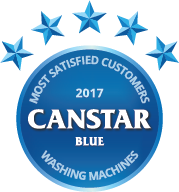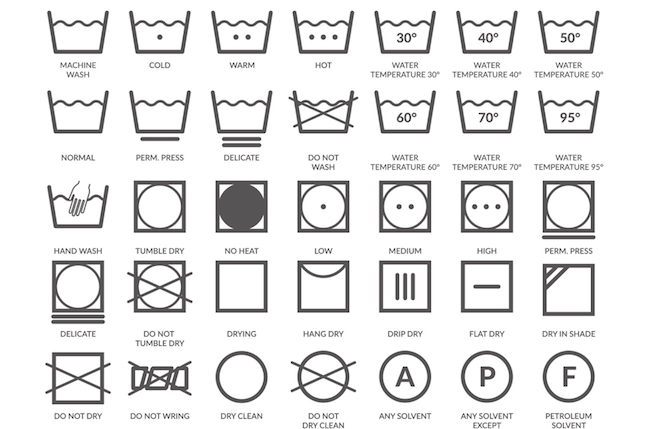2017 Washing Machines
Posted by Brittany Campbell-Akers August 23rd 2018
You are viewing the archived Washing Machine ratings. Follow the link to view the current Washing Machine rating page.
Compare washing machines in New Zealand at Canstar Blue. Bosch, Electrolux, Fisher & Paykel, Haier, LG, Panasonic, Samsung and Simpson were compared on value for money, performance and reliability, ease of use, quietness, design, warranty and service as well as overall satisfaction.
See our Ratings Methodology.

Most Satisfied Customers | Bosch
Bosch cleans up to take the Most Satisfied Customer Award for 2017.
Bosch wash top notch in our review
After missing out on the title last year, Bosch has once again taken top spot to claim the Canstar Blue Customer Satisfaction Award. This 2017 title means that since the awards started in 2012, Bosch has won an amazing six times.
But what do we like about our washing machines? How much do we expect to pay? And, what should we be considering when buying a new one? Well, hopefully that’s where we can help.
For most of us, a washing machine is pretty much an essential household appliance and although they’re a sizeable purchase – the mean spend for Kiwis is around $905 – they do tend to last a good few years. Unfortunately, when the time comes to buying a new machine, it can be pretty confusing with so many options to consider. Do you buy a top loader or a front loader? What size do you need? What’s the energy rating for?
In the latest Canstar Blue survey (July 2017) we asked 996 Kiwis what they thought about their recently bought machines and what satisfied them about their machines performance.
Not surprisingly performance and reliability was the largest driver of satisfaction as people want their wash to come out clean first time, have no maintenance issues and have a machine that’s just going to ‘get the job done’.
Customer Satisfaction award winner Bosch was the only brand to be given a maximum five stars for performance and reliability.
Next was value for money, which can be a pretty subjective category as it really does depend what you want in the first place and how much you expect to pay. The golden rule here is, work out what will suit you before you start to shop for a new machine and go with a budget in mind. Paying more for a flash machine is not going to give you value for money if you always use the same setting (as 38% of the people we surveyed admitted to doing).
Simpson and Electrolux both rated five stars for value for money with Bosch rating a respectable four stars.
Warranty and service gives peace of mind in knowing that you’re covered if things do go wrong.
Again, Bosch was the only brand to register five stars.
Design, ease of use and quietness were the final drivers of how satisfied customers were with their machines and again, Bosch took top spot with five stars in all of these areas.
Top or front loader?
The traditional top loader, with its large capacity and often shorted wash cycles is still popular in New Zealand but the more energy efficient front loaders still have a lot to offer.
We take a quick look at what each type of machine offers:
| Top loaders | Front loaders | |
|---|---|---|
| Pros |
|
|
| Cons |
|
|
Capacity
Buying the correct sized machine is very important. Too small and you will be doing a lot of extra loads. Too large and you will unnecessarily add to your energy and water bill. As a rule of thumb, 6kg–8kg capacity machines are suitable for families of four people, while couples and singles should need a capacity no greater than 5kg. Remember, your machine will last a while, so plan ahead.
Water and energy ratings
Another important consideration is the washing machine’s efficiency star ratings. Generally speaking, machines with a lower rating tend to be cheaper upfront than more efficient models. The flip side is that the (generally more expensive) energy and water efficient washing machines can save you money in the long term. Remember, the more stars it has, the more efficient it is. You can find a list of ‘super energy efficient’ washing machines on the energywise website.
Features
There are a myriad of features to look out for on both top loader and front loader washing machines. A few key ones to keep an eye out for include:
- Delayed timer: A delayed timer is a function that allows you to pre-set a start time for your washing machine. It can be used before bed to set the washing machine to operate during off-peak tariff periods.
- Wash settings: Certain washing machines have access to a range of washing options. Some notable ones include fast wash, hand wash, anti-crease, cold wash, warm wash, hot wash and heavy wash.
- Adjustable spin speeds: This function lets you change how fast your clothes are spun. Faster speeds result in dryer clothes at the end of the cycle, while lower speeds can be used to protect delicates.
- Stainless steel barrels: Cheaper washing machines will use porcelain coated steel, which can chip over time. Stainless steel barrels will usually last well beyond the rest of the washing machine.
What washing machine cycles should you be using?
Washing clothes is easy – simply dump your clothes in the machine, add some detergent and press the start button, right? Unfortunately, it’s a little more complicated than that if you want to properly look after your clothes. Different fabrics and colours require different treatment, and failing to wash them properly runs the risk of ruining your clothes. Washing different colours of clothing together can also lead to the dye running and the colours mixing and15% of the people we spoke to have done just that!
Another important part of washing is the care label on your clothes. Ignored at your peril! Sometimes it can be hard to understand what all those little symbols are, so here’s a quick guide to keep you right:

How to care for your washing machine
Keep it level: Regardless of whether you have a top loader or front loader washing machine, if it is not level, the barrel will be spinning at an angle. This can result in loud rattling or possibly the barrel dislodging.
Clean your washing machine: It may sound odd, but your washing machine also needs to be cleaned. But don’t worry, this is relatively easy – simply add baking soda and vinegar in lieu of detergent to your washing machine and start a full cycle with no clothes.
Reduce mildew growth: Certain washing machines and detergents do little to prevent the growth of thin layers of mould or mildew. Though this is easily dealt with by cleaning your machine on a monthly basis, growth can be slowed by ensuring you don’t leave wet clothes in the machine or by leaving the machine door open to allow air circulation.
Frequently asked questions
Canstar Blue commissioned I-view to survey 2,500 New Zealand consumers across a range of categories to measure and track customer satisfaction. The outcomes reported are the results from customers who have purchased and used a new washing machine in the last three years – in this case, 996 New Zealanders.
Brands must have received at least 30 responses to be included. Results are comparative and it should be noted that brands receiving three stars have still achieved a satisfaction measure of at least six out of 10. Not all brands available in the market have been compared in this survey. The ratings table is first sorted by star ratings and then alphabetically. A rated brand may receive a ‘N/A’ (Not Applicable) rating if it does not receive the minimum number of responses for that criteria.
